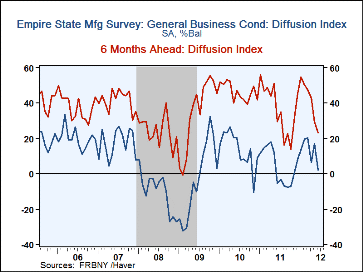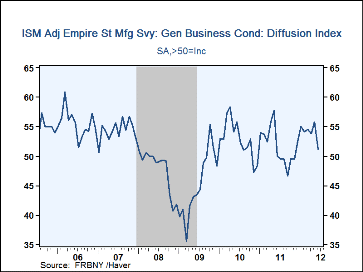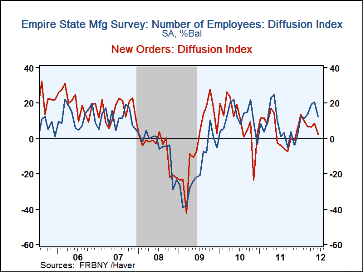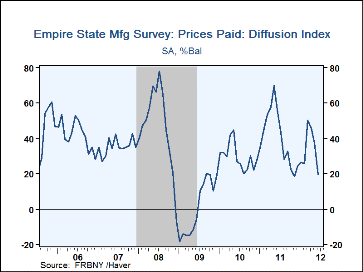 Global| Jun 15 2012
Global| Jun 15 2012Empire State Factory Index Falls Sharply
by:Tom Moeller
|in:Economy in Brief
Summary
The Empire State Factory Index of General Business Conditions for June retraced all of this year's improvement with a decline to 2.29 versus an unrevised 17.09 in May. Consensus expectations had been for improvement 14.0. Based on [...]
The Empire State Factory Index of General Business Conditions for June retraced all of this year's improvement with a decline to 2.29 versus an unrevised 17.09 in May. Consensus expectations had been for improvement 14.0. Based on these figures, Haver Analytics calculates an index that is compatible to the ISM series. The adjusted figure also fell sharply to 51.1, its lowest since November. Since inception in 2001, the business conditions index has a 64% correlation with the quarterly change in real GDP.
All of the component series deteriorated this month led by a lower shipments figure which was at its lowest since October. That was followed by a lower price reading of 19.59. During the last ten years there has been a 62% correlation between the index and the 3-month change in the intermediate goods PPI. The decline in the inventory figure was into negative territory and the unfilled orders series was negative as it has been for a year.
Lesser m/m declines were logged by new orders, also to it lowest since November, and employment to its lowest since February. During the last ten years there has been a 76% correlation by the jobs index and the m/m change in factory sector payrolls. The average workweek figure was zero for the second consecutive month.
Looking ahead, the Empire State index of expected business conditions in six months again fell sharply to its lowest since October. The decline was led by lower readings for prices, new orders and shipments. The figures for employment, technology spending and capital expenditure improved.
The Empire State figures are diffusion indexes which are calculated by subtracting the percent of respondents reporting poorer business conditions from those reporting improvement. Thus, they have a good correlation with growth in the series covered. The data is available in Haver's SURVEYS database. The ISM-adjusted headline index is calculated by Haver Analytics. The series date back only to 2001. The Consensus expectation figure is in Haver's AS1REPNA database.
| Empire State Manufacturing Survey | Jun | May | Apr | Jun'10 | 2011 | 2010 | 2009 |
|---|---|---|---|---|---|---|---|
| General Business Conditions (ISM Adjusted) | 51.1 | 55.8 | 53.8 | 50.1 | 51.7 | 52.9 | 45.2 |
| General Business Conditions (Diffusion Index, %) | 2.29 | 17.09 | 6.56 | -5.34 | 4.33 | 13.85 | -2.78 |
| New Orders | 2.18 | 8.32 | 6.48 | -2.38 | 3.99 | 9.93 | -2.51 |
| Shipments | 4.81 | 24.14 | 6.41 | -3.00 | 9.39 | 11.61 | 2.81 |
| Unfilled Orders | -5.15 | -4.82 | -7.23 | 0.00 | -5.29 | -6.58 | -13.36 |
| Delivery Time | 0.00 | 0.00 | 4.82 | -3.06 | -0.91 | -2.87 | -8.18 |
| Inventories | -8.25 | 4.82 | 1.20 | 1.02 | -1.80 | -1.48 | -22.89 |
| Number of Employees | 12.37 | 20.48 | 19.28 | 10.20 | 6.68 | 14.29 | -17.28 |
| Prices Paid | 19.59 | 37.35 | 45.78 | 56.12 | 40.66 | 29.63 | 1.33 |
Tom Moeller
AuthorMore in Author Profile »Prior to joining Haver Analytics in 2000, Mr. Moeller worked as the Economist at Chancellor Capital Management from 1985 to 1999. There, he developed comprehensive economic forecasts and interpreted economic data for equity and fixed income portfolio managers. Also at Chancellor, Mr. Moeller worked as an equity analyst and was responsible for researching and rating companies in the economically sensitive automobile and housing industries for investment in Chancellor’s equity portfolio. Prior to joining Chancellor, Mr. Moeller was an Economist at Citibank from 1979 to 1984. He also analyzed pricing behavior in the metals industry for the Council on Wage and Price Stability in Washington, D.C. In 1999, Mr. Moeller received the award for most accurate forecast from the Forecasters' Club of New York. From 1990 to 1992 he was President of the New York Association for Business Economists. Mr. Moeller earned an M.B.A. in Finance from Fordham University, where he graduated in 1987. He holds a Bachelor of Arts in Economics from George Washington University.










